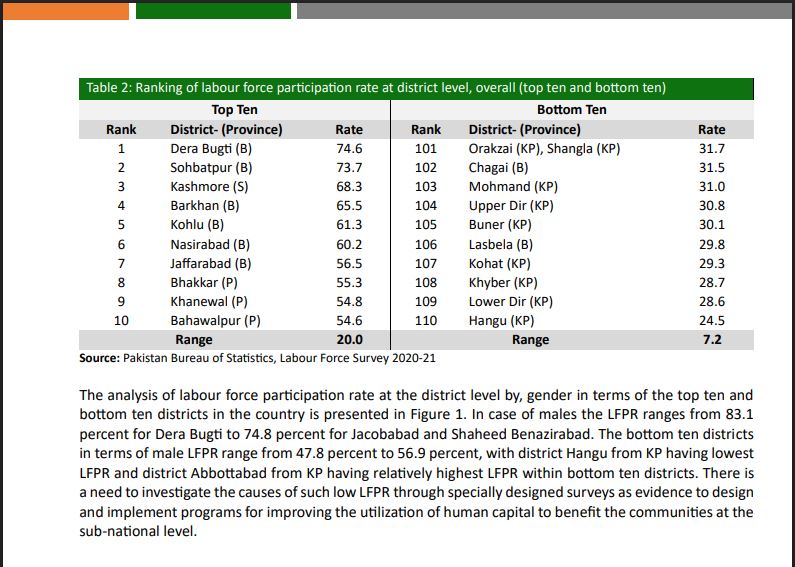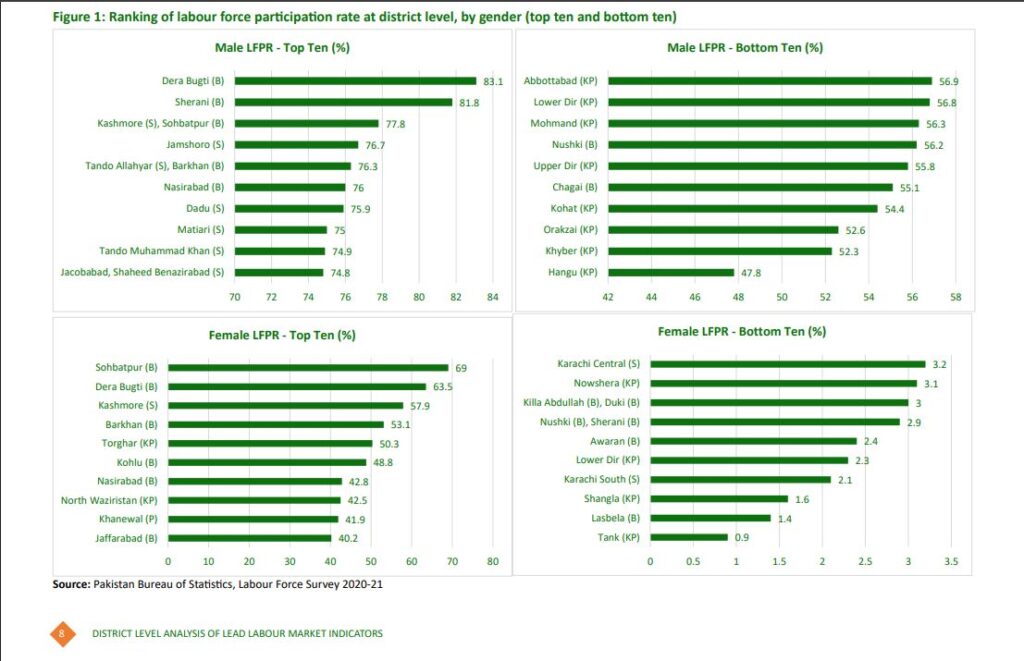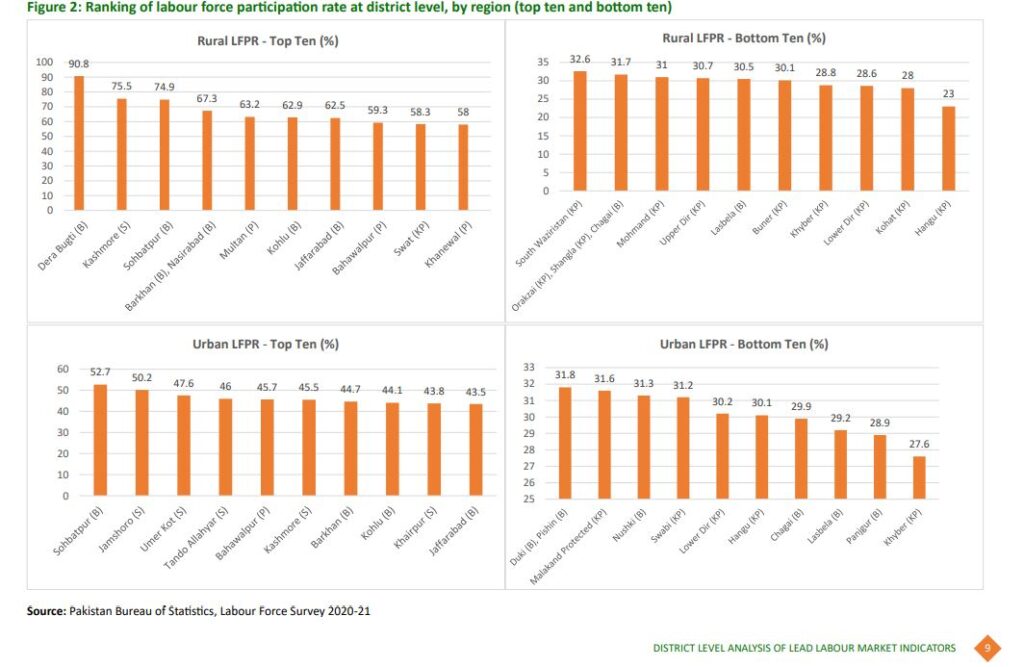- Rehan Ahmed
- Sep 16, 2025
Pakistan’s labour force participation disparities
Balochistan, despite its restive conditions and lagging performance on human development indicators, leads all provinces in the number of districts with the highest labour force participation rates. Remarkably, Dera Bugti ranks first among 131 districts across Pakistan. However, the province also reflects stark internal contrasts. Chagi and Lasbela in Balochistan are among the lowest-ranked districts for labour participation, highlighting deep regional disparities within the province.
Several compelling insights into the composition and dynamics of Pakistan’s labour force were examined in a recent report by Pride Consulting, titled “District-level analysis of lead labour market indicators”. The report was released via social media after formal platforms deferred or declined to host its launch.
According to sources, a federal ministry had initially scheduled the report’s launch but cancelled the event without providing any explanation, though the credibility of the report was confirmed by the Pakistan Bureau of Statistics (PBS).
Based on data from PBS’s first district-representative Labour Force Survey 2020-21, that draws on a sample of 100,000 households nationwide, the Pride report presents an analysis of nine key indicators selected from the broader set of labour market metrics developed and promoted by the International Labour Organisation (ILO).
According to the report: “Key findings include significant disparities in labour force participation rates across districts, with rural areas generally exhibiting higher participation…., partly due to the inclusion of contributing family workers. Employment-to-population ratios highlight stark gender disparities, with male ratios substantially higher than female ones across districts. Unemployment rates also vary widely by district and region, with some underdeveloped districts paradoxically reporting lower unemployment levels, warranting further investigation”.
This write-up focuses on a single key aspect of the report: the labour force participation rates, both male and female along with their respective district-level rankings. The relevant tables from the report are reproduced for reference.
Among the top 10 districts with highest labour force participation rates, six are from Balochistan, with Dera Bugti leading at 74.6 per cent. Other Balochistan districts on the list include Sohbatpur (73.7pc), Barkhan (65.5pc), Kohlu (61.3pc), Nasirabad (60.2pc) and Jaffarabad 56.5pc. The remaining three include Bhakkar (55.3pc), Khanewal (54.8pc), and Bahwalpur (54.6pc) from Punjab. Kashmore (68.3pc) is the only district from Sindh to feature, while no district from Khyber Pakhtunkhwa made the list.

Among the bottom 10 districts for overall labour force participation, eight are from KP: Orakzai (31.7pc), Mohmand (31pc), Upper Dir (30.8pc), Buner (30.1pc), Kohat (29.3pc), Khyber (28.7pc), Lower Dir (28.6pc), and Hangu (24.5pc). The remaining two Chagi (31.5pc), and Lasbela (29.8pc) are from Balochistan.
In the ranking of top 10 districts by gender, the underdeveloped provinces of Sindh and Balochistan account for five each of the top entries in male labour force participation. Conversely, nine of the bottom ten districts in male participation are from KP, with one from Balochistan. In female labour force participation six Balochistan districts rank in the top 10, followed by two from KP and one each from Sindh and Punjab. (Refer to charts for details.)

Without commenting on the findings that place remote districts of Balochistan ahead of more advanced regions, Dr Lubna Shahnaz, founding member and CEO of Pride Consulting, described the availability of district-level labour data as an invaluable opportunity for researchers and policymakers committed to inclusive and sustainable growth.
“For the first time, the PBS systematically collected district-level labour data in its latest Labour Force Survey, covering key dimensions and indicators of the job market. This has empowered the research community to gain deeper insights into labour dynamics across the country,” she said.

Dr Shahnaz emphasized the need for the government to build on this progress and move toward evidence-based policymaking to boost labour force participation and productivity, enabling the country to harness its most valuable asset—its large human resource base.
Referring to the report and its findings that some find controversial she said, “This is a purely academic initiative, with no political agenda. The purpose of the Pride report is to highlight key findings, and we chose to release it via social media for wider accessibility,” she added.
Senior officials approached for comments did not question the credibility of the Pride report but were reluctant to discuss its findings, particularly those related to Balochistan. Some challenged the accuracy of 2021 Labour Force Survey data on which the analysis is based, while others found the timing of the report’s release somewhat unusual.
Despite repeated follow-ups, no member of the government’s economic team offered a comment or provided an on-record explanation for the report’s findings, some of which appear to conflict with commonly held perceptions and basic logic.
A senior official, speaking privately, defended both the LFS and the report’s findings on labour participation. Addressing the unexpectedly high ranking of several Balochistan districts, particularly Dera Bugti, he explained: “Yes, Dera Bugti records the highest overall and female labour force participation, but this is largely in agriculture-related activities such as livestock and fodder fetching. Livestock is dominant livelihood in the region, and most of this work is informal, unpaid and self-directed. Entry into such work is easy and widespread, though retention is typically low.”
He contrasted this with urban areas like Karachi, where higher education and job retention levels are common, but employment is mostly in the formal sector, making entry more competitive and restricted.
Majyd Aziz, former president of the Employers Federation of Pakistan, noted that using district rank correlation provides a practical and reasonably accurate picture, considering Pakistan’s diverse regional dynamics. He suggested that high labour participation in areas like Dera Bugti may reflect the inclusion of child labour and home-based work, while Karachi’s lower rankings could stem from fewer such cases. He advocated for separate urban and rural rankings and believes updated data may reveal evolving patterns, particularly in female participation.




